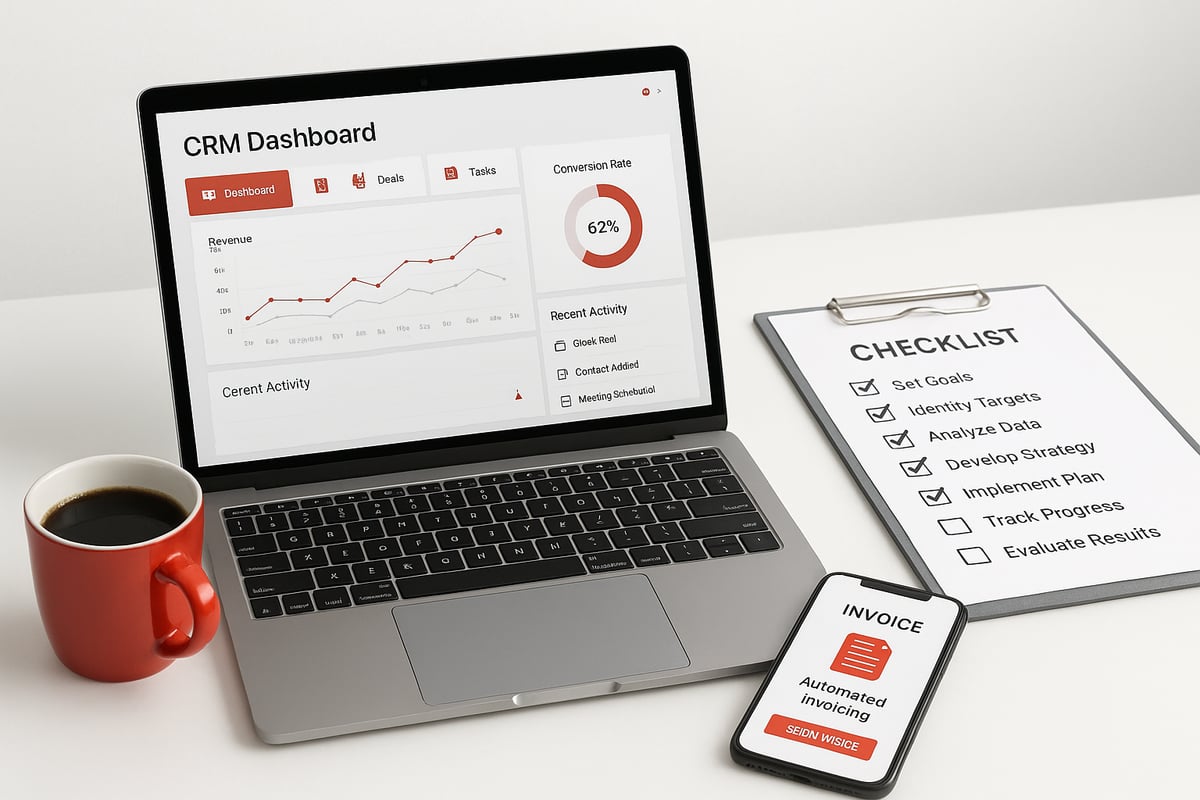Imagine seeing your business double its revenue and run smoother, all without adding more hours to your day. That’s the promise of growth systems: an approach that helps you work smarter, not harder.
This guide is here to show exactly how growth systems can help you get there.
Here’s what you’ll find inside:
- What growth systems are and how they work
- Why these systems matter for any business
- Proven, practical steps to build your own
- The best tools to keep you ahead of the curve
Ready to see real results? Let’s dive in and discover how simple changes can make a big difference for your business.
What Are Growth Systems?
Think of growth systems as the engine that keeps your business running smoothly, even as you take on more clients and bigger projects. Instead of relying on luck or one-off tricks, growth systems give you a reliable way to handle new opportunities, reduce stress, and keep quality high.

Defining Growth Systems
A growth system is a set of connected steps that help your business grow without chaos. It’s not a random mix of tools or quick fixes. Instead, growth systems are built on repeatable processes you can count on.
Let’s look at a few examples:
- Automated lead follow-up, so no potential client slips through the cracks.
- Seamless client onboarding, where every new customer gets the same smooth welcome.
- Scheduled check-ins with existing clients, handled by software, not sticky notes.
Unlike ad-hoc methods, growth systems are designed to run with little hands-on effort. Many owners discover that workflow automation for business growth is the backbone of reliable systems, letting you focus on bigger priorities.
Key Components of a Growth System
Every effective growth system has four main parts:
| Component | Description | Example |
|---|---|---|
| People | Who is involved | Sales reps, admin staff, managers |
| Processes | Steps that repeat | Client intake, scheduling, billing |
| Tools | Tech that connects it all | CRM, scheduling apps, invoicing software |
| Data | What you track | Response time, new leads, customer feedback |
You’ll need the right mix of people, clear steps, and easy-to-use tools. Data ties it all together, showing you what’s working and what needs improvement.
Growth systems aren’t just about tech. They’re about setting up a clear way to get results, so your team knows what to do and when.
Why Growth Systems Matter
Businesses with strong growth systems are 30% more likely to reach their revenue goals, according to HubSpot. These systems let you handle more work without burning out or losing your personal touch.
Consider a landscaping company. After automating scheduling and reminders, they doubled their client base in one year. The owner spent less time tracking appointments and more time building relationships.
Growth systems also help you avoid daily chaos. Instead of fighting fires, your team can focus on what they do best. You’ll see fewer mistakes, more satisfied clients, and a lot less stress for everyone.
Step-By-Step: Building Your Growth System
Building effective growth systems is a journey, not a single leap. Each step brings you closer to a business that runs smoother and grows with less stress. Here’s a practical guide for making it happen, one step at a time.

Step 1: Identify Bottlenecks and Opportunities
Start by looking for places where your daily work slows down. Think about the tasks that always seem to pile up or get missed. Ask your team and customers where things could be easier.
- Missed follow-ups can mean lost sales.
- Manual data entry might take longer than you think.
- Waiting for approvals could delay projects.
Checking in with your staff helps you spot what needs fixing. Growth systems begin with understanding where your time and energy are going.
Step 2: Map Out Repeatable Processes
Once you know your trouble spots, write out every step in your customer journey. Break big jobs into smaller pieces so nothing gets lost.
Tools like Lucidchart or even a whiteboard can help you see the flow. Make a checklist for each key process, such as onboarding a new client or sending invoices.
- Document steps in order.
- Note who is responsible.
- Highlight what can be repeated.
Growth systems shine when everyone knows what to do next. This makes your business more predictable and less stressful.
Step 3: Select the Right Tools and Technology
Now it’s time to pick the software that fits your needs. Think about what will help your business size and goals. You might need a CRM, automated invoicing, or a dashboard for tracking results.
Choosing wisely prevents headaches later. For more help on picking tech that supports growth systems, check out Selecting the right business software.
- Try demos before you buy.
- Look for tools that talk to each other.
- Ask your team what they find easy to use.
The right tech should make daily tasks quicker, not harder.
Step 4: Train Your Team
No system works if your team feels lost. Share the new process with everyone and give them a chance to ask questions.
- Use simple checklists or short videos.
- Host a quick workshop or demo.
- Encourage feedback and ideas.
Studies show teams that get training are more productive. Growth systems only work when everyone is moving in the same direction.
Step 5: Track, Measure, and Improve
Set clear goals for your new system. Decide what numbers matter most, like response times or repeat customers.
- Review results every month.
- Fix what isn’t working.
- Celebrate wins, even small ones.
Growth systems need regular checkups. This keeps your business moving forward and helps you catch problems before they grow.
Common Growth System Pitfalls and How to Avoid Them
Growth systems can transform your business, but a few missteps can stall progress or even cause setbacks. Let’s look at the most common pitfalls and how you can sidestep them for smoother, more reliable results.

Overcomplicating Systems
It’s easy to get excited and layer on too many tools or steps when building growth systems. The result? Teams feel lost, and no one follows the process.
- Start simple: Pick just one or two areas to automate first.
- Combine systems only when they genuinely save time.
- Use integration tools thoughtfully. For guidance on avoiding tool overload, see Software integration for small businesses.
A local design studio, for example, trimmed their software stack and saw fewer errors and happier staff.
Ignoring Team Buy-In
Even the best growth systems fall flat if your team isn’t on board. Change can be tough, and people need to feel included.
- Bring staff into planning discussions early.
- Collect feedback before launching anything new.
- Celebrate small wins as your team adapts.
When everyone feels involved, growth systems become part of daily habits, not just another checklist.
Neglecting Regular Updates
Growth systems aren’t set-and-forget. If you let them get stale, you’ll soon be back to patching problems by hand.
- Block time every quarter to review processes.
- Ask your team what’s working and what frustrates them.
- Adjust steps, tools, or roles as your business evolves.
A home services company improved efficiency by updating their lead tracking process each season.
Relying Only on Technology
Automating everything with software sounds tempting, but people and clear steps matter just as much in growth systems.
- Use tech for routine tasks, but keep some human touch.
- Review automated messages to avoid sounding robotic.
- Train staff to handle special cases with care.
A cleaning company paired automated reminders with friendly follow-up calls, boosting customer loyalty.
Missing the Metrics That Matter
Tracking the wrong numbers can send you off course. Growth systems work best when you focus on what truly drives results.
- Identify two or three key metrics for each process.
- Check these regularly, not just at year-end.
- Example: A plumbing business improved repeat sales by tracking customer return rates, not just new leads.
Paying attention to the right numbers keeps your growth systems effective and your business moving forward.
Essential Tools and Resources for Growth Systems
Finding the right tools can make all the difference when building growth systems. The right mix of resources helps you save time, keep customers happy, and focus on what really matters.

CRM Platforms
A strong CRM platform is at the heart of most growth systems. These tools help you keep track of leads, follow up with clients, and make sure no opportunity slips through the cracks.
Popular choices include:
- HubSpot
- Zoho CRM
With a good CRM, you can automate reminders, store client notes, and even send personalized emails. This keeps your team organized and your customer relationships strong.
Automated Invoicing and Payments
Manual billing eats up valuable hours and leaves room for mistakes. Automated invoicing solutions simplify payments, reduce errors, and help you get paid faster. For example, tools like FreshBooks and QuickBooks can send invoices automatically and track payment status.
Want to see how automating this step can improve your cash flow? Check out Automated Invoice Processing Benefits for a deeper look at how these systems help service businesses.
Adding automated billing to your growth systems reduces missed payments and lets you spend more time on your clients.
Scheduling and Project Management
Keeping your team and projects on track is much easier with the right scheduling and project management tools. Trello and Asana are top picks for businesses looking to create repeatable processes in their growth systems.
Use these tools to:
- Assign tasks
- Set deadlines
- Track progress
With clear timelines and responsibilities, your team can focus on delivering great results, not chasing down updates.
Analytics and Reporting Tools
You can't improve what you don't measure. Analytics and reporting tools let you visualize your progress, spot trends, and see which parts of your growth systems are working best.
Consider adding tools like:
- Google Analytics
- Databox
These platforms help you track metrics such as response times, conversion rates, and customer retention. With regular reviews, you can quickly adjust your approach and fix weak spots.
Adhesion Co.: Automated Growth Solutions for Service Businesses
If you're looking for a partner to help you build and maintain growth systems, Adhesion Co. specializes in custom automation for service businesses. They offer solutions for lead management, quoting, invoicing, and collecting customer reviews.
Highlights include:
- Rapid setup, tailored to your business
- Ongoing support as your needs change
- Free automation readiness assessment
- Access to a resource library with practical guides
Working with experts can take the guesswork out of creating growth systems that fit your goals.
Training and Support Resources
Even the best tools are only as good as the people using them. Training and support resources help your team stay confident and productive with new systems.
Look for:
- Online courses and webinars
- Peer groups and local business associations (like SCORE)
Investing in training keeps your growth systems running smoothly and encourages everyone to contribute new ideas. The right resources make it easier to adapt and thrive, no matter how your business evolves.
Keeping Your Growth System Future-Ready
Growth systems are never set-and-forget. Staying ready for what's next means being open to change, listening to your team and customers, and keeping an eye on new ideas. Here’s how you can make sure your growth systems stay sharp.
Adapting to Change
Markets and customer needs shift all the time. Your growth systems need regular check-ins to spot new opportunities or weak spots.
- Set a calendar reminder for quarterly reviews.
- Ask your team what’s changed in the way you work.
- Look at your data to spot trends.
If you see a process slowing down or customers asking for something new, tweak your system right away.
Encouraging a Culture of Improvement
Make it easy for your team to suggest changes. Growth systems work best when everyone feels comfortable sharing ideas.
- Hold monthly meetings to talk about what’s working.
- Keep a shared document for improvement suggestions.
- Celebrate when someone’s idea makes a real difference.
This habit keeps your growth systems flexible and helps avoid getting stuck in old routines.
Leveraging Customer Feedback
Your customers are a goldmine of ideas for improving growth systems. Use their feedback to refine your operations.
- Send short surveys after a project or service.
- Read through online reviews for common themes.
- Act on requests that come up repeatedly.
For example, if clients mention booking is confusing, add an online scheduler to make things easier.
Staying Informed on Tools and Trends
Technology moves fast, and growth systems need to keep up. Subscribe to newsletters or join industry forums to see what’s new.
- Attend webinars or workshops every few months.
- Watch for updates in your software tools.
- Explore how new tech, like artificial intelligence, can fit your business, as discussed in Leveraging AI for SME Growth.
This effort keeps your growth systems ahead of the curve and ready for any challenge.
Balancing Automation with Personal Touch
Automation is powerful, but it can never replace genuine connection. Make sure your growth systems use tech for routine tasks, but keep the human touch where it matters.
For instance, let automated reminders handle appointment confirmations, and follow up with a handwritten thank-you note after a big project. This balance builds trust and loyalty.
FAQs About Growth Systems
Have questions about growth systems? Here are some quick answers to help you get started.
What’s the difference between a growth system and regular business processes?
Growth systems are designed to help your business improve and expand by using repeatable steps, while regular processes focus on daily tasks.How long does it take to set up a growth system?
Most businesses can start seeing results in a few weeks. For guidance on mapping out your processes, check out Successful project management strategies.Do I need expensive software to build a growth system?
No, many tools are affordable or free, and you can start small before investing in more advanced options.How can I tell if my growth system is working?
Track key numbers like client retention and follow-up speed. If you see improvements, your system is on the right path.What’s the best way to get my team on board?
Involve them early, share clear instructions, and celebrate wins together.Can small businesses benefit from growth systems, or is this just for big companies?
Growth systems help businesses of any size save time and reduce stress. Even a small team can benefit from the right system.
As you look ahead to 2025, you deserve more than just working harder—you deserve a business that works smarter for you. We’ve explored how growth systems can streamline your operations, eliminate manual bottlenecks, and free up your time to focus on what matters most. If you’re ready to see where your business stands and what it could achieve with the right automation, take the first step today. Discover your potential and identify the key areas where you can unlock real efficiency with our quick, personalized assessment. Get Your Automation Readiness Score

.png)